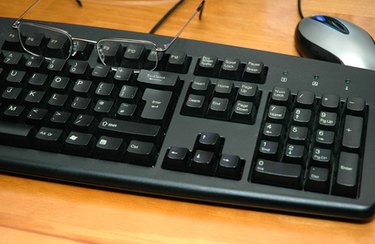
Small children and pets often play with the computer keyboard, which may be fun for them, but can cause problems for you. This practice can erase important information from your computer or accidentally adjust the settings. These hassles can be avoided by locking the PC keyboard to avert errors from unwanted hands or pets on your keyboard.
Using the Keyboard
Video of the Day
A keyboard shortcut to lock the keyboard is built-into the Windows operating system. You can lock the keyboard by pressing the "Windows" key and "L" simultaneously. The keyboard can be accessed again by pressing "Enter" and typing in your password, if one is set. When the keyboard is locked, the PC will preserve work and applications in the previous state.
Video of the Day
Using a Shortcut Icon
You can lock the keyboard by creating a shortcut icon. This can be achieved by right- clicking on a blank space on the desktop and selecting "New," then "Shortcut" and typing "rundll32.exe user32.dll, LockWorkStation" (without quotes) in the field. Complete the action by clicking on "Next," then "Finish." Double-click on the shortcut that you created on your desktop to lock the keyboard.
Using the Command Prompt
The PC keyboard can be locked by using command prompts. Locking the keyboard can be achieved by navigating to the "Start" menu, then selecting "Run" and typing "cmd" (without quotes) in the field. Finish the action by clicking "OK." Complete the action by typing in "rundll32.exe user32.dll, LockWorkStation" and clicking "Enter." After the keyboard is locked, nobody else can use it. But the computer is still on.
Lock Windows Session
If your keyboard lacks a "Windows" key, you can still lock the keyboard by pressing "CTRL" + "Alt" + "Del" keys simultaneously for a few seconds. If the Windows Security window appears, select "Lock Computer." If the Task Manager window instead appears, select "Shutdown," then "Lock Computer" to lock the keyboard. Typing in your computer's password will log you back into the computer when you power it on.